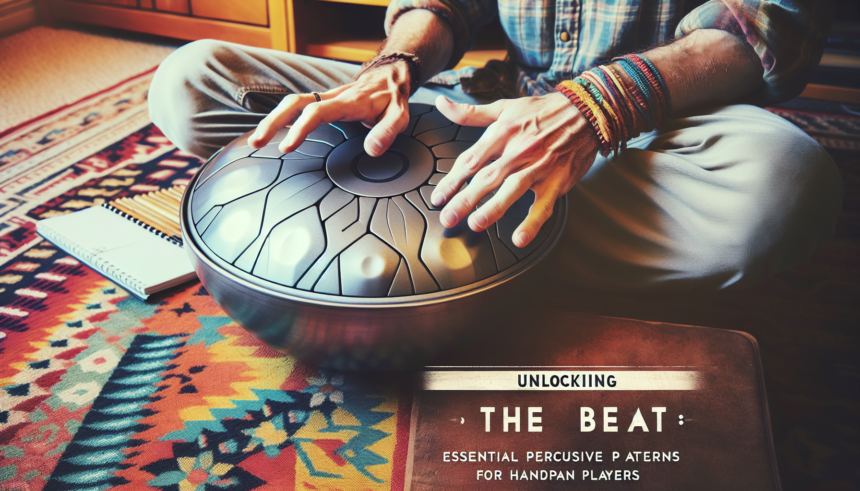Unlocking the Beat: Essential Percussive Patterns for Handpan Players
The handpan, with its alluring, ethereal soundscapes, has been capturing the hearts and minds of musicians and listeners alike since its inception. This unique instrument, resembling a UFO, produces sounds that are rich, resonant, and full of harmonic overtones. One aspect of playing the handpan that is often underestimated is the role of percussive patterns in enhancing the overall musical experience. This article aims to explore essential percussive patterns that every handpan player should know to unlock the full potential of this remarkable instrument.
Understanding the Basics
Before delving into specific patterns, it’s crucial to understand some fundamental aspects of handpan playing. Firstly, the instrument is typically played with the hands and fingers, with each handpan featuring a central note or “ding” surrounded by a series of tuned tone fields. The beauty of the handpan lies in its capability to be percussive as well as melodic, allowing players to create complex rhythms and harmonies simultaneously.
The Importance of Rhythm
Rhythm is the backbone of music. Without rhythm, even the most beautiful melodic lines can feel aimless and uninspired. Percussive patterns provide structure and form to your handpan playing, making your performances more engaging and dynamic. By incorporating rhythmic elements, you can transform a simple musical phrase into a compelling piece of art.
Basic Hand Techniques
To effectively play percussive patterns on the handpan, mastering the following hand techniques is essential:
1. Slap
The slap is a sharp, percussive sound produced by striking the rim or the edge of a tone field with the fingers or palm. This technique is excellent for adding accents and emphasizing certain beats in your patterns.
2. Tap
The tap is a lighter, more subtle touch, usually performed with the fingertips. This technique allows for quick, precise articulations, making it ideal for intricate rhythmic patterns.
3. Open Tone
An open tone is achieved by striking the tone field with a relaxed hand, allowing the note to ring out fully. This technique is fundamental for producing clear, resonant melodic lines.
4. Muting
Muting involves partially or fully damping the sound by placing the hand on the tone field immediately after striking it. This technique is effective for creating shorter, staccato notes and adding dynamic contrast to your playing.
Essential Percussive Patterns
Now that you have a grasp of the basic techniques, let’s explore some essential percussive patterns that can enhance your handpan playing:
1. Basic 4/4 Groove
The 4/4 time signature, also known as “common time,” is the most widely used in music. A simple 4/4 groove can serve as the foundation for more complex patterns. Here’s a basic example:
(Slap) – (Tap) – (Open Tone) – (Tap)
The slap adds a strong accent on the first beat, while the tap provides a light touch on the second and fourth beats. The open tone on the third beat adds melodic interest and resonance.
2. Syncopation
Syncopation involves placing emphasis on typically weak beats or offbeats, creating a sense of rhythmic tension and surprise. Try this pattern:
(Tap) – (Slap) – (Tap) – (Open Tone)
In this pattern, the slap on the second beat creates a syncopated feel, while the open tone on the fourth beat provides a resolution.
3. Triplets
Triplets divide a beat into three equal parts, adding rhythmic diversity and fluidity to your playing. Here’s a triplet pattern to practice:
(Tap) – (Tap) – (Slap) – (Tap) – (Tap) – (Open Tone)
The triplet feel adds a flowing, rolling quality to your rhythm, making it perfect for more expressive, lyrical passages.
4. Double-Stroke Rolls
Double-stroke rolls involve alternating taps between the hands, creating a fast, continuous sound. Use this technique to build intensity and drive in your patterns:
(Tap-Tap) – (Tap-Tap) – (Slap) – (Tap-Tap) – (Tap-Tap) – (Open Tone)
The rapid taps provide a steady, driving rhythm, while the slap and open tone add dynamic variation.
5. Flam
The flam is a percussive technique where a grace note precedes the primary stroke, creating a “flammed” effect. Incorporate flams for added rhythmic complexity:
(Tap-Slap) – (Tap-Tap) – (Open Tone) – (Tap-Flam)
The flam adds a quick, subtle embellishment to your rhythm, giving it a more nuanced and layered sound.
Combining Patterns
One of the most exciting aspects of playing the handpan is the ability to combine different patterns to create unique, intricate rhythms. Experiment with these patterns and mix them to develop your personal style. Here are a few combinations to try:
1. Basic Groove + Syncopation
(Slap) – (Tap) – (Open Tone) – (Tap) – (Tap) – (Slap) – (Tap) – (Open Tone)
This combination alternates between a basic groove and a syncopated rhythm, adding interest and variation.
2. Triplets + Double-Stroke Rolls
(Tap) – (Tap) – (Slap) – (Tap-Tap) – (Tap-Tap) – (Tap-Tap) – (Slap) – (Open Tone)
The triplets and double-stroke rolls work together to create a fast, flowing rhythm with plenty of movement.
3. Flams + Basic Groove
(Tap-Flam) – (Tap-Tap) – (Open Tone) – (Tap) – (Slap) – (Tap) – (Open Tone) – (Tap)
Using flams within a basic groove adds a subtle, intricate texture to your rhythm, making it more engaging.
Conclusion
Mastering essential percussive patterns is a key component of becoming a proficient handpan player. By incorporating a variety of rhythmic techniques and patterns, you can elevate your playing and create captivating musical experiences. Remember to practice these patterns regularly, experiment with different combinations, and most importantly, have fun exploring the rhythmic possibilities of the handpan.
FAQs
1. What is the best way to practice percussive patterns on the handpan?
Start with slow, deliberate practice to ensure accuracy and precision. Gradually increase the tempo as you become more comfortable with the patterns. Use a metronome to maintain a steady rhythm and focus on developing a relaxed, fluid playing technique.
2. How do I create my own percussive patterns?
Experiment with different combinations of basic techniques (slaps, taps, open tones, and flams) and time signatures. Record your practice sessions and listen back to identify interesting rhythmic ideas. Don’t be afraid to explore unconventional rhythms and create your unique style.
3. Can I use percussive patterns in solo handpan performances?
Absolutely! Incorporating percussive patterns in solo performances can add depth and complexity to your music. They can serve as a foundation for improvisation, creating dynamic contrasts, and enhancing the overall musical narrative.
4. How do I transition between different percussive patterns smoothly?
Practice transitioning between patterns slowly and gradually increase the speed. Focus on maintaining a consistent rhythm and smooth hand movements. Use natural pauses and breathing points in your music to facilitate seamless transitions.
5. What are some advanced percussive techniques for the handpan?
Advanced techniques include ghost notes, polyrhythms, and metric modulation. Ghost notes are played very softly, adding subtle accents and texture. Polyrhythms involve playing multiple contrasting rhythms simultaneously. Metric modulation involves changing the perceived tempo by shifting rhythmic emphasis. These techniques require practice and a solid understanding of rhythm.





